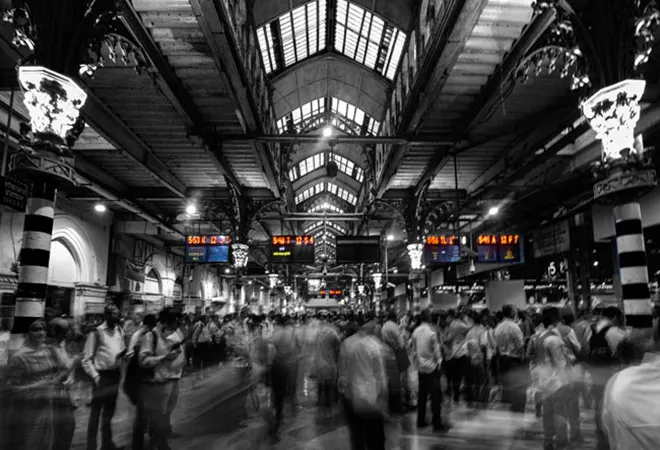-
CENTRES
Progammes & Centres
Location
Reckless urbanisation that does not provide for quality of life to the citizens may be counterproductive for the desired levels of growth.

Last month, in an article titled Urbanise fast for high growth, Columbia University economist Arvind Panagariya argued that “rapid urbanisation has been a key feature of economies that have sustained 8-10% growth for two to three decades.” He cited the examples of South Korea and China. The two countries in a period of three decades added 57 percent and 32 percent respectively to their urban population, pulling millions of poor rural agricultural workers into well-paid manufacturing jobs in cities that propelled the meteoric rise of their economies. Unfortunately, India’s urban population over 60 years (1951-2011) rose just 14 percent at 2.3 percent per decade, failing to attract rural workers in massive numbers to move to cities and towns.
The Economist highlighted the lack of affordable rental housing as the chief culprit that has impeded rapid Indian urbanisation. Workers wanting to migrate to cities were disabled by the non-availability of low-cost rental shelter. He prescribed a number of correctives — reform rental laws, hive off excess land held by central and state governments and institutions, hike the traditionally low floor-space index, make land use change liberal, continue the anti-corruption drive to drive out black money from real estate and reform the Land Acquisition Act to bring in speed and cost rationality in acquisition.
There can be no dispute with the cited observation that urbanisation propels economic growth. Around the globe, western countries are the most urbanised and have had the highest economic growth. Within India itself, Tamil Nadu and Maharashtra have the highest urbanisation and the largest economies. There can be some argument that India’s urbanisation is not as low as the Census figures reveal. There is a fair bit of hidden urbanisation that has taken place in peri-urban areas — still treated as rural. However, even if we were to count such populations as urban, India’s urbanisation does not remotely compare with China and South Korea. Quite clearly, if India desires high growth, it has to catalyse urbanisation. It is this that will propel its economic rise. However, looking at its past record, India has still not bought this theory despite the entire west and countries like Japan, China and South Korea adopting it long ago. The anti-city Indian mindset that pervaded during Independence has not been entirely eschewed. Rural India still is the focus and, in the normal course, will continue to be in vogue till such time the urban demographic profile remains smaller than the rural.
During the last seven decades, Indian cities have witnessed the complete neglect of rental housing. They have also seen the trepidation of states to touch the rent laws enacted during the world war days, discarded around the world but preserved as if they were cherished heritage in India. The cited article’s emphasis on the sinister role played by the rent laws is absolutely right and must bear the responsibility for skewing not only urban housing, but for casting a long shadow on the healthy development of cities.
One, however, needs to point out that the migrating poor in India did find a way of working outside the stated law. They forced themselves on the city in the shape of massive slums. Over a period of time, states were obligated to recognise them, regularise them and provide basic services through state slum legislation. However, that is not how a city ought to grow and may not have grown, if abundant low-cost rental housing had been built and if rent laws had not stood in the way. The Government of India in 2015 came out with the National Urban Rental Housing Policy (NUHRP) and followed it up with a recommendatory Model Tenancy Act, 2019 (MTA). The response of the states, however, has been tepid. As usual, it appears that perceived threat of political damage would trump the manifest national economic tragedy.
Equally valid is the argument that in keeping with the imperial past, government and its institutions have cornered huge tracts of land in most major cities. Even more economically damaging is the fact that they have made no efficient use of it. They have thereby created scarcity of land and hugely pushed up land costs. Combined with other factors, a situation has been created in which the large mass of urbanites must conduct their lives — living and working — in a small fraction of the city’s geography. No wonder, for instance, that 50 percent of Mumbai’s population lives in less than 10 percent of the city’s land.
The Right to Fair Compensation and Transparency in Land Acquisition, Rehabilitation and Resettlement Act, 2013 (RFTLARR) that has been passed by Parliament has had disastrous consequences for public land acquisition. In urban areas, two times the Annual Ready Reckoner rate (ARR) must be paid to the owner. This effectively means almost two times the market rate. It has exponentially raised the cost of land acquisition, making it difficult for public bodies to find the money. No city is now in a position to fund its development plan, primarily because it cannot buy land, thereby creating a situation in which cities will always run short of public amenities. However, having enacted such a law, it is most unlikely that any political party will summon sufficient courage to dilute it.
The two other suggestions deal with land use conversion and Floor Space Index (FSI). Panagariya has argued that there should be more liberal conversion of land use and a much higher cap on FSI. In theory, these ideas have merit, but both need to be approached with great care in the Indian context. Land use conversions have been the subject of great mischief and malfeasance in large cities. This is despite the long process of notifications and calling for objections. It is absolutely essential that the entire process is made transparent and full justification is shared with the citizenry on what prompted land use change. This level of transparency and public consultation seen in western countries is still not in place in India. Till this is done, easy land use conversion is likely to do more damage than good in cities.
There is also no doubt that a flat FSI regime in a city is not a good idea. Commercial FSI needs to be high so that lowered land costs and density of commercial activity generate cost-benefits and higher productivity. Residential FSIs, however, need to be reasonably low for quality living and prevention of overcrowding, especially for the poor. In Indian cities, despite low FSI, a whole range of additionalities are available. There is fungible FSI and higher FSI for education and health facilities. Furthermore, a variety of Transfer of Development Rights (TDR) could get generated. This is a land-linked instrument allowing the owner of a land to part with it in exchange of TDR (in lieu of cash) that can be used for construction elsewhere in the city in excess of the normal stipulated FSI. The kinds of TDR that commonly get generated are land acquisition TDR, road-widening TDR, heritage TDR and slum TDR. These push up the average consumed FSI in the city. With these additions, Mumbai, for instance, ends up with an average FSI three times its normal. What is also significant is that even with a low FSI regime, Indian cities have the highest demographic densities in the world. It would be vital, therefore, to view the question of FSI cap in the light of what impact it would have on a specific city in providing living and working space and on human density.
It is inevitable for India to urbanise fast for high growth. However, reckless urbanisation that does not provide for quality of life to the citizens — the way India has urbanised so far and is continuing to commit the same mistakes — may actually be counterproductive for the desired levels of growth. It might even lead to widening social and economic divide between the country's urban populace.
The views expressed above belong to the author(s). ORF research and analyses now available on Telegram! Click here to access our curated content — blogs, longforms and interviews.

Dr. Ramanath Jha is Distinguished Fellow at Observer Research Foundation, Mumbai. He works on urbanisation — urban sustainability, urban governance and urban planning. Dr. Jha belongs ...
Read More +